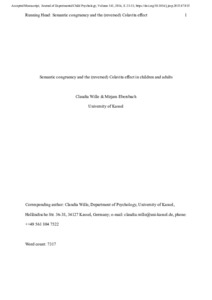| dc.date.accessioned | 2021-07-29T15:01:41Z | |
| dc.date.available | 2021-07-29T15:01:41Z | |
| dc.date.issued | 2016 | |
| dc.identifier | doi:10.17170/kobra-202103253602 | |
| dc.identifier.uri | http://hdl.handle.net/123456789/13050 | |
| dc.language.iso | eng | eng |
| dc.rights | Attribution-NonCommercial-NoDerivatives 4.0 International | * |
| dc.rights.uri | http://creativecommons.org/licenses/by-nc-nd/4.0/ | * |
| dc.subject | colavita effect | eng |
| dc.subject | visual dominance | eng |
| dc.subject | auditory dominance | eng |
| dc.subject | semantic congruency | eng |
| dc.subject | perception | eng |
| dc.subject | multisensory processing | eng |
| dc.subject.ddc | 150 | |
| dc.title | Semantic congruency and the (reversed) Colavita effect in children and adults | eng |
| dc.type | Aufsatz | |
| dcterms.abstract | When presented with auditory, visual, or bimodal audiovisual stimuli in a discrimination task, adults tend to ignore the auditory component in bimodal stimuli and respond to the visual component only (i.e., Colavita visual dominance effect). The same is true for older children, whereas young children are dominated by the auditory component of bimodal audiovisual stimuli. This suggests a change of sensory dominance during childhood. The aim of the current study was to investigate, in three experimental conditions, whether children and adults show sensory dominance when presented with complex semantic stimuli and whether this dominance can be modulated by stimulus characteristics such as semantic (in)congruency, frequency of bimodal trials, and color information. Semantic (in)congruency did not affect the magnitude of the auditory dominance effect in 6-year-olds or the visual dominance effect in adults, but it was a modulating factor of the visual dominance in 9-year-olds (Conditions 1 and 2). Furthermore, the absence of color information (Condition 3) did not affect auditory dominance in 6-year-olds and hardly affected visual dominance in adults, whereas the visual dominance in 9-year-olds disappeared. Our results suggest that (a) sensory dominance in children and adults is not restricted to simple lights and sounds, as used in previous research, but can be extended to semantically meaningful stimuli and that (b) sensory dominance is more robust in 6-year-olds and adults than in 9-year-olds, implying a transitional stage around this age. | eng |
| dcterms.accessRights | open access | |
| dcterms.creator | Wille, Claudia | |
| dcterms.creator | Ebersbach, Mirjam | |
| dc.relation.doi | doi:10.1016/j.jecp.2015.07.015 | |
| dc.subject.swd | Experimentelle Psychologie | ger |
| dc.subject.swd | Entwicklungspsychologie | ger |
| dc.subject.swd | Akustischer Reiz | ger |
| dc.subject.swd | Visueller Reiz | ger |
| dc.subject.swd | Wahrnehmung | ger |
| dc.type.version | acceptedVersion | |
| dcterms.source.identifier | eissn:1096-0457 | |
| dcterms.source.journal | Journal of Experimental Child Psychology | eng |
| dcterms.source.pageinfo | 23-33 | |
| dcterms.source.volume | Volume 141 | |
| kup.iskup | false | |


